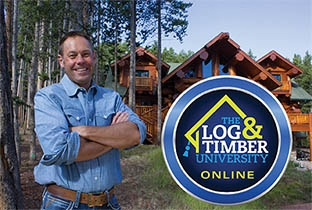Photo by Mark Sorenson
When it comes to this question, whether you can finance a new log or timber home, the short answer is a resounding “Yes!” Financing is a critical component of owning a home for most people. So, when it comes to log or timber projects, financing is certainly possible — it just may look a little different.
According to Robert Jones, Executive Vice President of the Federal Savings Bank and an expert in financing log and timber homes, a strategic, step-by-step approach ensures a smooth experience. That starts with finding the right lender, and the rest will fall into place.
“It is critical to investigate your lender,” explains Robert. “There are so few lenders who are willing to do a construction loan for a log or timber home.” Additionally, the customer should take the time to ask about loan options. “There is no one-size-fits-all. Having options for conventional, FHA and VA financing should be an important consideration for a borrower when choosing their lender.”
Armed with years of experience, the experts at the Federal Savings Bank have answers to the most frequently asked questions from prospective log or timber homeowners. They take time to understand those aspects of the process that are somewhat unique not just to the log and timber industries, but to each and every project.
“Our team has been together for many years and has funded thousands of construction loans,” explains Robert. “We are trained to take our time with our customers to make sure they have a full understanding of the financing process. We discuss down payment options, interest rates, terms of their loan, as well as the draw schedule process. We provide constant communication to both our borrower and the builder to help ensure the customer has an outstanding home financing experience.”
Log and timber home lenders agree that a key component of a smooth financing experience is to start the process early. And while you’re at it, contact more than one company. Representatives should be happy to help. Even if you only have a rough idea at the time, it pays to begin these conversations sooner rather than later.
The tools you’ll need for that first conversation with the lender are pretty straightforward. You’ll want to have…
- Personal financial information, such as a current financial statement listings asset and liabilities, including cash available to inject in the project.
- Documentation requirements vary from one lender to another, but having two or three years of personal tax returns available is beneficial.
- Self-employed borrowers should expect to provide further tax documentation on any business entities.
From there, a lending advisor will begin to develop a picture of what’s possible via a thorough examination of the borrower’s ability to repay the mortgage. Prospective borrowers should have a clean credit history and solid accompanying credit score. Most lenders will target a ratio of existing and proposed monthly debt to total income of 35-40 percent, while the payment for the proposed mortgage should be 25 percent or less of total monthly income.
The lender’s analysis of debt to income provides a framework for the amount of funding a borrower can support. This leads to the conclusion of the realistic size and scope of the project. In short, it determines the financial feasibility of the borrower’s proposed cost to complete the project. Lenders will then extend financing that ranges typically from 75 to 85 percent of total project cost. One footnote — cash is king, and a healthy reserve gives the lender confidence that a borrower can push through any unforeseen expense or surprise during construction.

Financing pros who specialize in log and timber construction know the subtleties of the process, including common bumps in the road. Take for example, appraisals, which require a nuanced understanding. Robert explains: “Having quality appraisers who understand the nuances of log homes is critical to having a great financing experience. Banks who are accustomed to financing log or timber homes will work with experienced professionals with regards to appraising a log or timber home.”
Leveraging the time and talent of a qualified and proficient lender takes the mystery out of a process that homeowners may navigate only once or twice in their lives. This measured approach helps set expectations for everything from paperwork and expenses to approval and construction schedules.
Being secure in the knowledge that homeowner satisfaction is the top priority for the experts at The Federal Savings Bank offers one of the most valuable assets of all — peace of mind.













